The best standing desks
The results are in after two months of testing.

By Kevin Purdy
This post was done in partnership with Wirecutter. When readers choose to buy Wirecutter's independently chosen editorial picks, Wirecutter and Engadget may earn affiliate commission. Read the full standing desks guide here.
After two months of unboxing, building, using, testing, and comparing eight of the newest standing desks side by side, we think the Uplift Bamboo Stand Up Desk with 1" Thick Desktop and V2 Frame is the best desk for people who want a relatively stable surface that looks good, moves quickly and quietly, and should give you the fewest problems in working every day. But several other standing desks are nearly as good, and a few are worth considering.
The Uplift bamboo desktop was every tester's favorite, particularly the (optional) ergonomic groove cutout in front. You can kit out the Uplift with a number of accessories that match your desk style, including power and cable organizers. It wasn't the best at everything, but the Uplift had the best mix of performance and features, and a lack of glaring flaws, of all the desks we tested. Just make sure you get the V2 frame (Uplift still sells the earlier model, which is a bit less stable). Though the Uplift is not the most rock-solid standing desk we tested this time, it's more stable than the desks we've recommended (and used happily) for years. The desks that were more stable had other flaws, like loud motors or ugly laminate tops.
If you want to buy a standing-desk mat and monitor arm at the same time, you should consider the Fully Jarvis Bamboo Standing Desk, because it is a good standing desk that offers those extras in a package deal. The Jarvis was our top pick for more than four years, and is still a desk we recommend. The latest version of the Uplift frame and desktop felt more stable, particularly front-to-back, than the latest Jarvis frame when we tested both in late 2018. But the difference is not enormous; standing-desk stability is hard to measure precisely, and a half-dozen Wirecutter staffers have used Jarvis desks daily for years. The Jarvis's ¾-inch-thick bamboo desktop is thinner than the Uplift's 1-inch top, and looks lighter; otherwise they're nearly identical. In addition to the mat and monitor arm, Fully sells furniture and desk add-ons that mesh well with the Jarvis's look that you can purchase at a discount while ordering the desk, while the Uplift offers small upgrades, like powered grommets and privacy shields.
The Varidesk ProDesk 60 Electric is more stable in each direction than the Uplift or Jarvis, and a little bit quieter than those desks in raising and lowering (minus an occasional thudding sound when starting). It also comes with built-in cable management, and was the easiest desk we've ever built. But it has no wood or bamboo desktop options, just five colors of laminate, which our testers disliked. If desktop style is not a high priority for you, and you'd rather pay a few hundred dollars more to have a more stable, quieter desk with easier assembly, the ProDesk 60 Electric could work for you—but we recommend the white or black finishes rather than the faux wood.
It was a close call for many of the full-size electric standing desks we tested; several were near picks, except for flaws that will be dealbreakers for some people. Check out our impressions in the Competition section for more.
If you're interested in adding a standing adapter to your existing desk, we are researching and testing standing desk converters for a separate review. For now, we still recommend the Kangaroo Pro Junior by Ergo Desktop, which has been our converter pick for four years. It provides a decently smooth and low-effort transition from sitting to standing, it keeps your monitor, mouse, and keyboard more stable than most desktop units we tested, and it doesn't require a very deep desk, or render a big chunk of your desk space unusable except for computer work.
Why you should trust us
Wirecutter has been testing and comparing full-size adjustable standing desks since 2013. Between three guide authors, we've tested more than 24 full-size standing desks, including multiple iterations of popular and noteworthy models.
We've consulted the work of experts in the field of standing, ergonomics, and productivity. This includes the work of James Levine of the Mayo Clinic, an early advocate for varying work positions during the day. We've spoken with Shane Harris, one of the first journalists to write about modern-day standing desks. As part of our work on other home office guides, we've read and extensively referenced Cornell University's Human Factors and Ergonomics Research Group (CUErgo). And we've written and spoken extensively with the makers of many of the standing desks we've tested.
Beyond our particular experience with standing desks, Nathan Edwards (editor of this current guide) and I have written and edited a number of Wirecutter guides to home office items, furniture, and electronics. I've written guides to foam mattresses, USB microphones, dog crates and gates, and edited collections of home office furniture and supplies and tech and apps, as well as Wirecutter's guide to standing desk mats. Nathan wrote or edited several previous versions of this guide and the standing desk mat guide and has been working at an adjustable-height standing desk since 2014.
Should you buy a standing desk (and do standing desks improve your health)?
Several peer-reviewed studies agree that sitting for long periods of time can shorten your life. Sitting for eight hours a day or more can be a health risk similar to obesity or smoking, according to an analysis of 13 studies, and can be linked to increased occurrence of cancers, per this broader study of 4 million people in 43 studies. Being moderately active for 60 to 75 minutes per day can counter the effects of too much sitting. But can a standing desk also counter the damage of sitting? This is not yet proven. Wirecutter's parent company, The New York Times, published a stronger opinion by a pediatric doctor, with headlines suggesting standing desks are "overrated" and "not cures for anything."
This does not mean a standing desk is not beneficial in ways that do not directly affect your mortality. Smaller studies, like one from the University of Leicester, have shown improved productivity from using a standing desk. I tend to agree. Standing in the early morning, or after lunch, helps me stave off drowsy lulls in focus. Working in a sit/stand/move cycle encourages me to occasionally fetch a glass of water, itself a good habit, and can also be adapted to a Pomodoro Technique habit.
Having an adjustable standing desk means you have an adjustable sitting desk, too. Those who don't fit well sitting at a mass-produced average-height desk (29 to 30 inches) can slightly raise or lower their desktop, and keep that better position in the desk's memory.
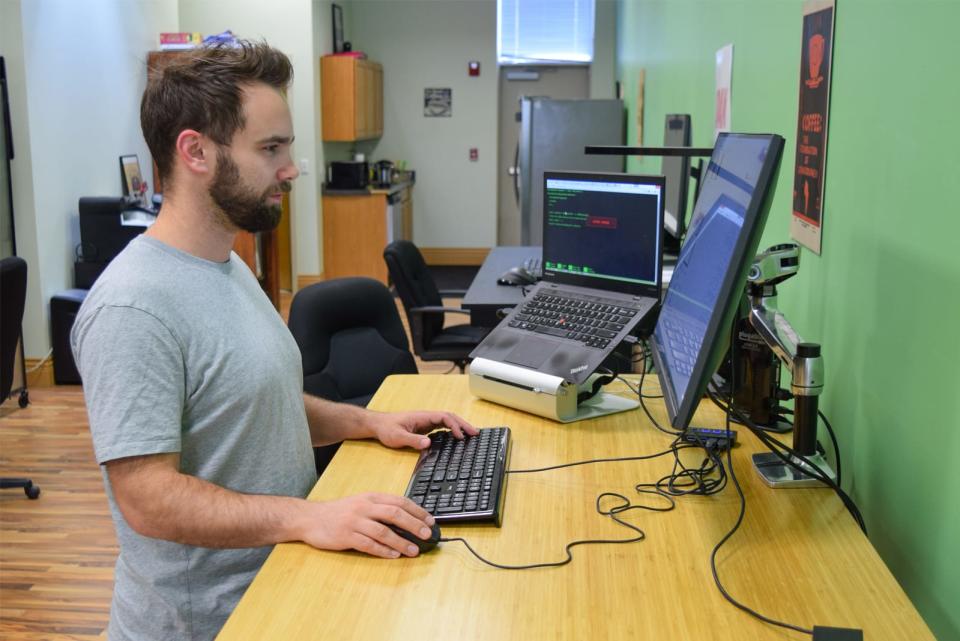
Standing at your desk won't help you much if you don't have your angles and ergonomics down. You want to have proper line of sight, and good positions for your back, elbows, shoulders, and neck. This 2012 graphic from Wired remains the simplest way to illustrate the proper standing desk goals: monitor slightly tilted back, eyes aimed about two inches below the top of your monitor, keyboard and mouse at elbow level or slightly below.

Avoiding overdoing standing is just as important as keeping from sitting all day. As Cornell's Hedge told US News and World Report, "If what you're doing is replacing sitting with standing, you're not actually doing your body any favors ... In fact, you're introducing a whole variety of new risk factors." Those factors include lower back pain, and increasing your risk for cardiovascular problems.
How we picked

From years of using and testing standing desks, and getting feedback from readers and commenters, we have focused our criteria on what we're looking for in a standing desk. Among the things we value are:
Electronic control: Electronic desks, which use motors to move between heights at the touch of a button, are the most popular, reliable, and cost-effective adjustable standing desks available. Hand-cranked and hydraulic desks can work for some, but involve a lot of trade-offs, mostly in convenience and annoyance.
Long-term function: Because most fully adjustable desks cost at least $500, they should be stable and functional for a decade or more. The company behind a desk should offer speedy, reliable support, and show an intent to be in the ergonomic furniture business for the long haul.
Purchase experience: A new desk should ship reasonably quickly and be reasonably convenient to assemble (within the bounds of any do-it-yourself furniture assembly).
Customization: You should have some options in how your desk looks, and how big it is. Some standing-desk makers sell their frames separately from their desktops, so customers can add their own desktop. But most people are going to want something that looks good out of the box, with a size, shape, and options that fit their work.
Height range: A standing desk should have minimum and maximum heights that accommodate as wide a range of human heights as possible—around the 95th percentile for men and women is good (PDF), but a wider range is better. Some desk makers charge more for legs that extend their height range, and we noted that in our comparisons.
Accessories and add-ons: Some desk makers offer accessories for their desks, such as grommet cable guides (some including power plugs), privacy screens, or CPU holders. Others offer accessories to outfit your office and complement your desk. We looked at everything each desk maker offered, and considered whether they were useful, affordable, and, in some cases, already Wirecutter picks in their own right (such is the case for monitor arms, LED desk lamps, and standing desk mats).
How we tested
With those priorities in mind, we tested eight desks in 2018, including the current models of several desks we've tested before:
We configured each of these desks as closely as possible to our ideal standard desk:
a desktop 60 inches wide by 30 inches deep
a memory handset, to hold sitting and standing positions
two grommet cutouts, on the rear left and right side, if available
a crossbar, if available
All of the desks, save one, were unpacked, assembled, and used in rotation by workers at CoworkBuffalo, a (since-closed) coworking space in Buffalo, New York, for about two months.1 I rotated between each desk every working day, while about a half-dozen other workers used the other desks. Toward the end of the two months, I gave each worker a questionnaire about each desk they had used, asking about stability, noise, look, and feel.
Wirecutter editor Kimber Streams and I worked at each desk and compared them side by side. Each desk was loaded with a laptop and monitor or laptop on a stand, a mouse and keyboard, and a few other items, like phones or notebooks. We graded each desk for stability in three directions: vibrations while typing, front-to-back, and side-to-side. You can get any two-legged desk to wobble by shoving it, but we tried to apply pressure the way most people will: by leaning with their forearms on the desk while standing and typing (for front-to-back stability), or leaning into their writing on paper (for left-to-right stability in particular).
We tried using vibrometer apps for measuring typing vibrations, and chalk markings to measure the distance a desk would move, but found in the end that liquid in a clear Mason jar set on the desk provided a better sense of what someone would find annoying. I did use a decibel meter to measure the level of motor noise as a desk raised and lowered, although the pitch and particular kinds of noise that a motor makes matter just as much as raw volume.
While we focused most of our testing on the performance of the desk itself—the desktop on top of the motorized legs—a few desks did arrive with accessories, like power-supplying grommets, wire-management tools or containers, or shelf attachments. We considered how useful they were and, if they cost extra, whether they were worth the price.
Our pick: Uplift Bamboo Stand Up Desk with 1" Thick Desktop and V2 Frame

The Uplift Bamboo Stand Up Desk with 1" Thick Desktop and V2 Frame was one of the best desks according to every criterion we tested, and had no major drawbacks. It transferred few typing or writing vibrations, was stable in front-to-back movement, and was the most stable among desks that lacked a crossbar. It moved quickly between positions and made little noise when raising and lowering. Uplift's inch-thick bamboo desktop was testers' favorite, and can be configured with a curved front that many testers liked. Uplift offers hundreds of configurations of desk materials and colors. The desk is backed by a seven-year warranty, and sold by an established firm in the standing-desk field.
The Uplift was notably more stable than many desks we tested. The desk transferred less vibration across its surface as we typed with our palms and forearms resting on the desk than the Jarvis, StandDesk, Xdesk, or Updesk. It is remarkably solid in side-to-side movement, especially considering it has no crossbar. The front-to-back wobble is acceptable for a desk standing on two legs at more than 40 inches tall. You can get it going by rocking it back and forth, but most people don't do that while they're working.

We found three other desks to be more roundly stable than the Uplift: the VariDesk Pro (our also-great pick), the VertDesk v3 detailed in the Competition section, and the commercial version of this Uplift desk (also addressed in the Competition section). But the VariDesk Pro is more expensive and less attractive, and offers fewer options and accessories. The VertDesk v3 is much louder and trickier to assemble, and offers only laminate tops (if nicer laminate than on the VariDesk). And the commercial version of the Uplift is meant mostly for offices that have to comply with a wider range of heights, and adds a crossbar that some taller people may find annoying to bump with their shins.
The Uplift's two leg motors make a small amount of noise as it raises and lowers, with a sound and a pitch that are easy to get used to. We measured about 55 decibels while raising and lowering (with a starting room level of 42 to 44 decibels), a common level among five of our eight tested desks. The desk moves quickly once you press the up/down or memory position buttons, and doesn't lurch or stutter. The buttons have a satisfying click to them, and you know when you have them pressed in or not. We wouldn't mention this if hadn't been an issue with the StandDesk and VertDesk we tested.
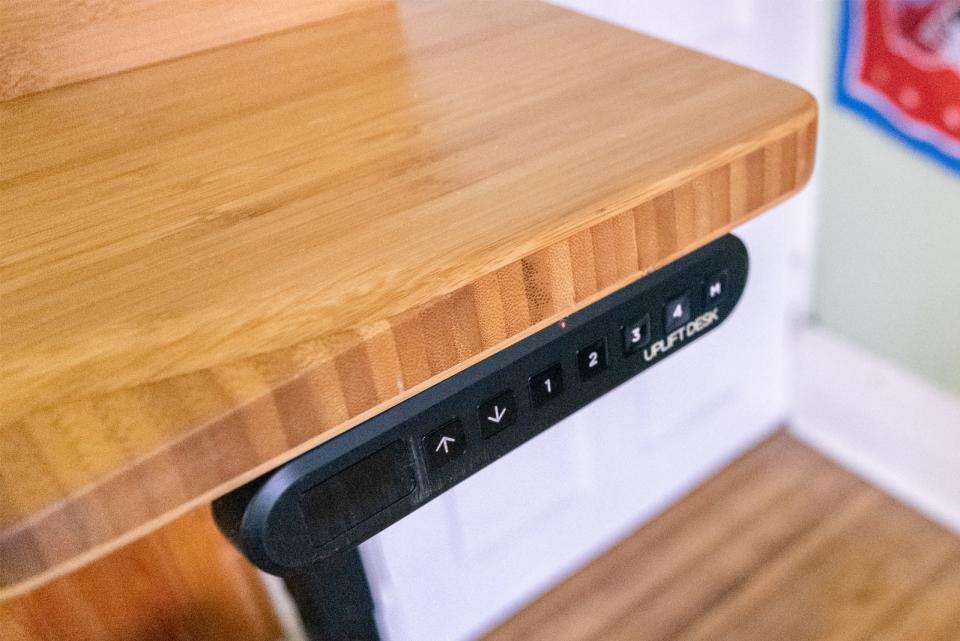
Most bamboo desktops we tested looked good and felt smooth, but Uplift's 1-inch-thick desktop was the favorite of desk testers. The variations of dark grooves in the light bamboo are pleasant, and particularly noticeable if you choose a contoured desk shape. This desktop looks and feels substantial. Its lamination hasn't shown any notable nicks or scratches after two months of constant equipment changes. It's a generally attractive and useful desktop, whether raised or lowered.
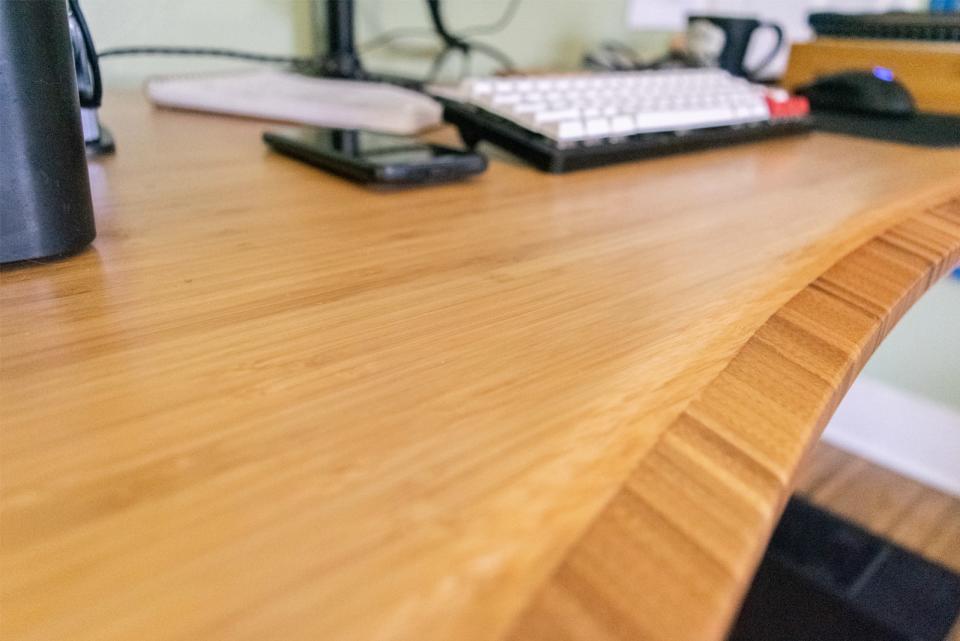
Uplift has a few more options for look, functions, and little details than Fully offers for our runner-up pick, and far more than most standing-desk makers. Your desktop can be bamboo, rubberwood, powder-coated wood composite, Greenguard (low-emission-certified) laminate, reclaimed wood, solid woods, or with a whiteboard laminate coating. Each of those options then has two or more wood or color options, a handful of size options, four leg colors, then grommet covers—powered or unpowered—with three color choices. Its memory handset (an upgrade we recommend everybody get) even comes in three color options.
The assembly experience is a bit better than average for an adjustable-height standing desk. Uplift's instructions have numerous illustrations, a few troubleshooting tips, and only three distinct types of screws to use. We encountered no problems or confusion while building the Uplift, whereas most other desks left us wondering at least once what the instructions meant, or irked that the last screw and its machined hole weren't lining up right when attaching a leg. But assembling the Uplift still involved a good deal of screwdriver and hex wrench work.
Uplift offers a seven-year warranty on its desks, and the firm has offered standing desks since 2011. The Uplift desk we built and tested in spring 2016 experienced no problems in the more than two years we've been long-term testing it. Two Wirecutter staffers similarly have nothing to report. The newest Uplift model as of fall 2018 is more stable and offers more desktop options, but those staffers with older models have not noticed problems with stability, noise, or other wear.
The Uplift adjusts in height from 24 to 51.1 inches, including the desktop. That should provide an ergonomic typing height for people up to 6 feet 6 inches tall. That covers about 96 percent of the American height ranges. Adding locking casters can add another two inches.
Uplift gives desk buyers a couple of free accessories with purchase, and while they're not a deciding factor for a purchase this big, they're not bad. A basic stick-on wire tray is included, which is quite useful for hiding a power cord and thick cables. Uplift's standing desk mat is nowhere near as good as our pick, or even our budget pick, but it's handy to have when you first get your desk unpacked. A free bamboo or colored plastic desk organizer set, or four-port USB 3.0 hub, is useful. If you're already set with a mat, the bamboo rocker board is, according to a coworker, a decently fun low-impact core workout. And if you order a desk 72 inches or wider, you can choose a free hammock. Yes, a hammock that attaches with carabiners to the frame of the desk, that you can sit in (cross-legged) underneath your desk while it's raised. This hammock held me, at 200 pounds, for as long as I could stand the mental image of myself.
Note that the version of the Uplift desk we recommend is specifically a "V2" frame. As of this writing, Uplift still sells the previous version of its frame (a runner-up in the previous version of this guide), and configuring a desk or browsing around Uplift's site may lead you to that "V1" frame. An Uplift representative told us the V1 frame will be sold until the company runs out of stock. Be sure to check the name when you order.
Flaws but not dealbreakers
As noted, the Uplift is not the most stable standing desk we tested, but it is more than stable enough to work at, exceeds our picks from previous years, and had the best combination of stability, noise, looks, features, and other criteria. If you do work with your hands on the desk and move forcefully, and you can't tolerate a bit of monitor wobble or coffee moving in a cup at standing height, you could turn to the VariDesk ProDesk, our also-great pick, for a slightly more stable experience, or the VertDesk v3 if you value stability at the expense of more irritating motor noise and a less handsome desk. You could also pay $200 more for Uplift's V2 Commercial, which is slightly more stable due to its thicker lifting legs, steel feet, and crossbar. We don't think most people will find the increase in stability worth the extra 30 percent in cost (from about $650 to $850 for a 60-inch-by-30-inch desktop), but it's available with most of the same options, and benefits, as the standard Uplift.
As noted above, the assembly process for an Uplift desk is about what we've come to expect from standing desks over the years. But it can be done better, and a few other companies are doing so. The Varidesk ProDesk comes with the top of the frame pre-attached to the desktop, includes better tools for assembling the desk, and took only about 20 minutes to assemble. The StandDesk is a more traditional assembly process, but helped along by well-labeled parts and little arrows and graphics to make sure everything is lined up correctly. I lost a couple of bolts inside the adjustable upper crossbar of the Uplift while trying to insert them from the side into the legs. Uplift's marketing director, Brian Genchur, wrote us that most loose bolts should be able to fall out of the crossbar by tilting the desk up from where the bolt was lost (I couldn't retrieve my bolt this way without tilting the whole desktop back and forth a few times).
If you don't spring $30 extra for the basic wire-management kit, the small, stick-on wire ties included with the Uplift won't last all that long before falling off, in our experience. A wire tray is included, but you'll want to invest in some zip ties, Velcro strips, or Velcro tape to really clean up your cords.
The downside of offering so many options, accessories, and upgrades is that you have to click dozens of times to get through the ordering process on Uplift's site. It's a one-time task for a desk you'll use for years, but it can feel like you're missing something, and the site's organization can make you wonder if there's another category of desk you should look at. While writing this guide, I realized that I was, at first, linking to the wrong version of the standing desk I'd tested.
Runner-up: Fully Jarvis Bamboo Standing Desk
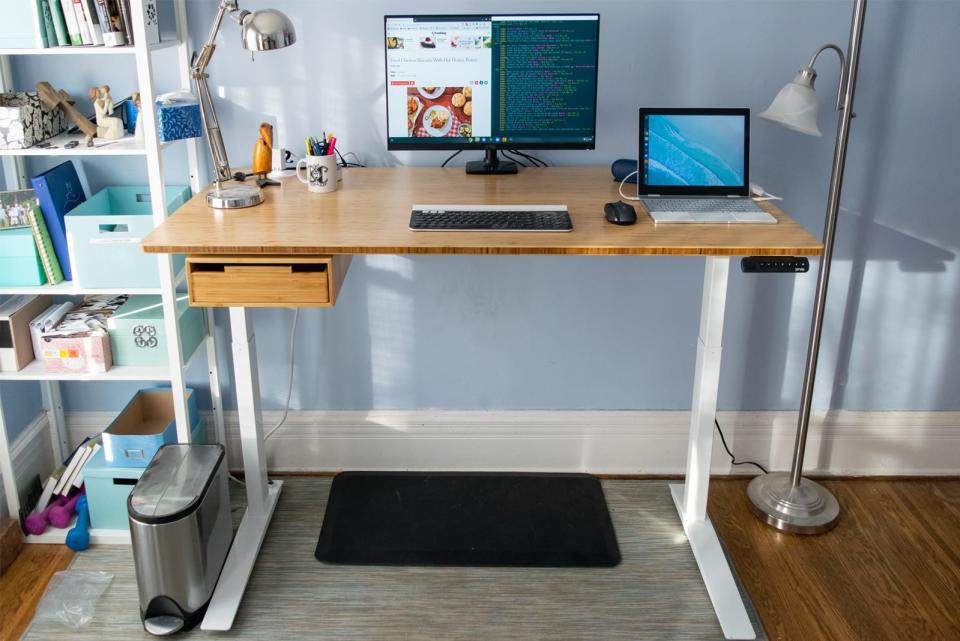
The Fully Jarvis Bamboo Standing Desk is very similar to the Uplift desk. The main differences are a desktop that's a bit thinner (¾ inch versus the Uplift's 1 inch), telescoped legs that are smaller at the desktop instead of at the feet, and different desktop options and add-ons available, along with the mechanical and design decisions you can't see at a glance. We found the newest Uplift frame to be more stable than the newest Jarvis in typing, front-to-back, and side-to-side motion. But the Jarvis is still stable enough for most people's work, has a sleek look that some testers preferred, and offers useful add-ons like shelves and drawers.
One of our testers for this update, and more than a half-dozen Wirecutter staffers, have worked at Jarvis desks for years with no complaints about its function. We noticed a difference only when directly comparing it with the newest Uplift frame and other desks we tested with even more stability. Any two-legged desk at standing height will convey some typing and mouse-motion vibrations, particularly to a monitor, whether on a stand or an arm, or to a laptop, on a stand or sitting directly on the desk. The Jarvis can move a bit more front to back when you forcefully lean into it, but most times you aren't going to forcefully lean into it.

It is slightly quieter than the Uplift when raising and lowering, measuring about 55 decibels in our tests (with a background noise level of about 42 to 45 decibels), and it responds quickly to button presses. The bamboo desktop is elegant and simple, thinner than the Uplift (¾ inch thick versus 1 inch), which may explain the disadvantage in vibration transfer) and with fewer dark spots (though desktops will vary a bit). Like Uplift, Fully offers a range of desktop materials, colors, and sizes, and a contoured or flat-front option. Building the Jarvis is about the same experience as the Uplift, although Fully has a much better page of instructions and how-to videos.
While Uplift has a huge array of add-ons and accessories, Fully offers a smaller number of upgrades for the Jarvis, and they're better quality. Fully makes two other Wirecutter picks, a monitor arm and (runner-up) LED desk lamp, that you can bundle with the Jarvis for good discounts ($20 and $40, respectively). You can add a desk shelf that matches your frame color, and a bamboo drawer that's the same as Jarvis's light bamboo, and both are easy to add onto the desk later (though you'll have to drill some holes for the drawer). The powered grommet covers have both USB-A and USB-C ports, a small but future-facing nicety.
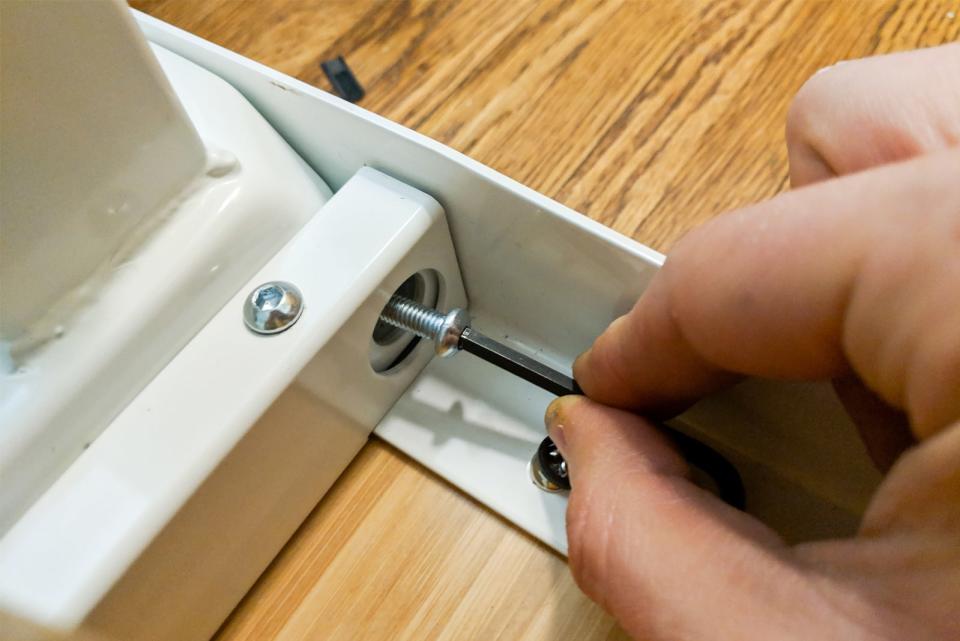
Building the Jarvis is a lot like building the Uplift, or most any standing desk. We encountered the same pain we experienced with the Uplift when trying to bolt the legs onto the frame, with bolts falling into the metal channel. Fully CEO David Kahl wrote to us saying that this is the most complicated but also most important step in assembly. Kahl said he puts the legs on their back, so the cable is facing upward, and lines up the topmost holes on each side to better align all of the screws.
Also great: Varidesk ProDesk 60 Electric
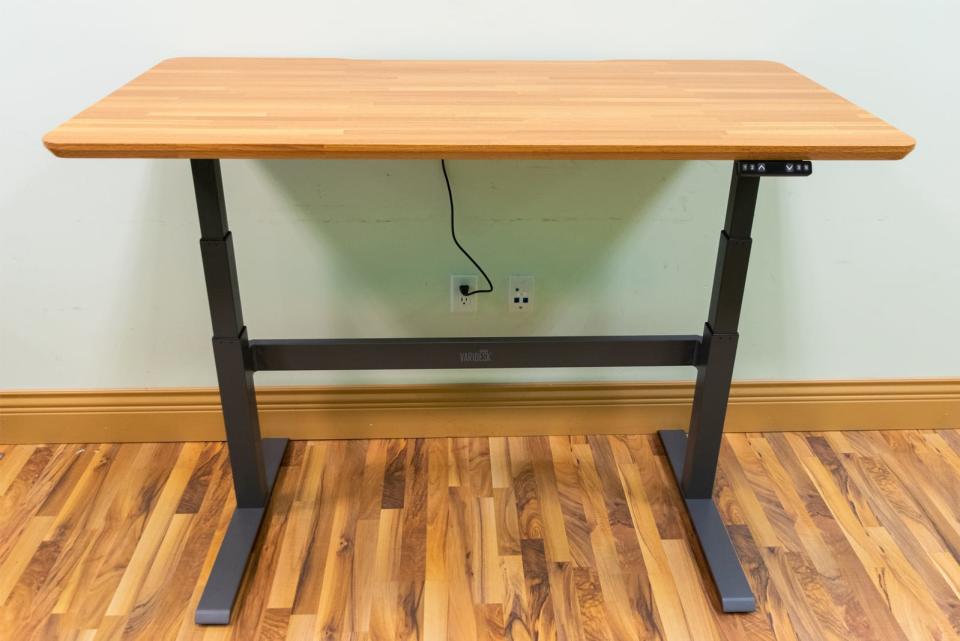
Were it not for the look and feel of its laminate top, combined with its higher price, Varidesk's Pro Desk 60 Electric would have been our top pick. It's more stable in every direction than the Uplift or Jarvis, it's the easiest to build of any standing desk we've tried, its motors are slightly quieter and the noise less noticeable than that of most desks, and it has good cord-management tools built in. However, the butcher block laminate desktop we tested reminded us of little-missed furniture from our parents' basement, but if the black or white versions appeal to you, or you don't care as much about looks, the ProDesk Electric is worth considering.
The ProDesk Electric's motor made the least noise of any we tested, and our testers noted how smooth and quiet the leg motors were compared with the competition. The motor makes a soft "thud" sound upon starting if the desk hasn't moved in a while (something a Varidesk rep confirmed via email), but it's quick and tolerable.

While Varidesk's claim of "under 5 minutes" for assembly is an exaggeration, it's not that hyperbolic—a coworker and I built the desk in about 18 minutes, compared with at least 45 minutes for our other picks and most other desks. Other desks we tested leave the alignment of parts and tightening of bolts up to you. Forgetting to tighten a bolt at the end, or trying to make a screw fit in at an angle, can affect the stability of your desk. The Varidesk has you insert four bolts, tap a crossbar into place with a provided rubber mallet, and snap a cable-management bucket into place.
The ProDesk Electric shows a lot of attention to detail, down to the comfortable handle on the included hex wrench and the hook-and-loop cable-management strips that are long enough to fit around the desk legs. So it's a shame that the laminate desktop we tested reminded us of decades-old desks offered for free in a garage sale. The laminate itself is sturdy, eco-friendly Greenguard, but the photo reproduction and the completely smooth surface just feel off. We haven't seen a black or white desktop in person, but they seem like better bets. Varidesk spokesperson Haley Vondekamp wrote, in response to our critiques of the desktop, that laminate is easy to clean and maintain, makes the desktop durable and affordable, and allows for the desktop's chamfered edges. But, especially for the $1,000 price, it sticks out as a downgrade from our other picks.
The competition
Notable desks we tested
VertDesk v3

The VertDesk v3, sold by BTOD.com (Beyond the Office Door), is the most stable two-leg standing desk we've ever tested. If the most important thing in your desk decision, by far, is stability when standing, you should buy this desk. We didn't pick it for most people because of its plain look, noticeably louder motor, and an assembly process that's notably more involved than that of most desks we tested. It also costs a bit more than our top picks, which are stable enough for most people.
Unlike most desks we've tested, the VertDesk v3 raises and lowers with a single external motor, rather than two. It ran about 10 to 12 decibels louder than the other desks we tested in the same space, 65 to 67 decibels with a background average of 42 to 45 decibels. It's also a higher-pitched whine than most other desks, which have either lower-end rumble or mid-range whirring. Some testers in our coworking space noticed and mentioned the noise, or shot us a glance when the motor was running. Greg Knighton, president of BTOD, wrote us that his testing showed the motor only 3 to 4 decibels louder than the latest motor in a Jarvis desk.
The motor also hesitates for about a half second or so after you press the up or down buttons before moving. This won't matter much if you only move the desk between preset memory positions, but making tiny adjustments for things like different shoes, using a mat, or other things take more effort here than with other desks we tested.
Building the VertDesk is notably more complex than other desks we tested. The legs are raised with a single motor, which connects to both legs with a hex rod that must be turned to fit inside each leg's slot. While doing this, you must ensure you don't turn the rod so much to make either leg raise, or pick up the leg and extend it, or you will have to take the leg off and start again, like I did. BTOD's instruction videos are honest about the work involved, and show the motor assembly. The work with a screwdriver, hex wrench, and all-but-mandatory drill with a No. 2 square bit is notably more involved than with other desks we tested. Knighton told us by phone that our assembly problem was uncommon, and that the instructions would be updated to prevent more issues.
If you're okay with a desk that makes more noise (like if you're working from home), you don't mind taking on more involved assembly, and stability matters far more to you than looks or accessories, consider the VertDesk v3.
StandDesk Pro (p3 model)

The StandDesk Pro we tested was quite similar to our runner-up Jarvis pick in stability, with decent typing/movement transfer, fair-to-okay front-to-back stability, but better side-to-side stability (with a crossbar attached), and the best instructions and labeling we'd seen for building a typical standing desk (excluding the Varidesk ProDesk Electric). It was a very close call between the StandDesk and Jarvis for runner-up. Its desktop looks good and feels comfortable under your arms, and the desk's raising and lowering noises are very slightly quieter than those of our top pick and runner-up. Unfortunately, the StandDesk's motor doesn't respond as quickly, and its control pad isn't as precise or easy to use as the Jarvis or Uplift's.
What diminished the StandDesk's ranking for us was the control panel and some hesitancy in the motor response. The keypad is plastic-covered, and the buttons don't click so much as push in. That made it easier for your finger to slip and the desk to stop moving when adjusting height, which happened to two Wirecutter staffers. It doesn't help that the keypad has dots for memory settings instead of numbers, has only three memory settings instead of four, and displays 0.5-inch increments, unlike the 0.1-inch detail of our top pick and runner-up. The desk still moves in smaller increments than 0.5 inches, but only after a little hesitation. That hesitation, combined with the uncertainty of the button pushes, makes adjustment harder than it needs to be.
Steven Yu, founder of StandDesk, wrote us that customers surveyed by StandDesk prefer the membrane-type switches, but the company plans different handsets for the future. The handset has had minimal issues over 10 years, Yu said, and noted that the enclosed buttons are impervious to liquid spills or dust. A slower startup and raising speed provides for longer lifespan, Yu wrote, and again noted that he hasn't heard customers complain about this issue.
Other desks we tested
Xdesk Terra 2s
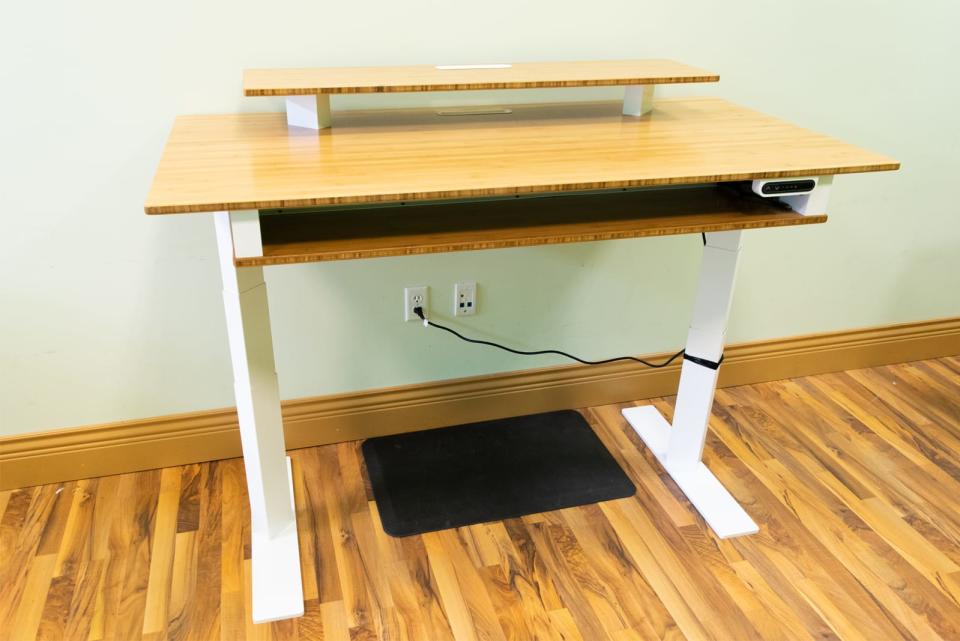
The XDesk Terra 2s is a beautiful desk, with perhaps the nicest bamboo we tested, painted legs that show almost no marks from their assembly, and a wide central grommet that works well for monitor setups. The desk comes partially assembled, sparing you a good 20 minutes of work over the typical assembly. However, it costs more than twice as much as our picks—starting at $1,700— it's louder than any of them, and significantly less stable, particularly in its front-to-back wobble.
We could feel the desk flexing on its thin, flat feet—made out of "aircraft grade" aluminum—even when we nudged the desk at sitting height (most of the cheaper standing desks we tested have steel feet). The legs are turned 45 degrees inward, but this does not seem to add any stability to the frame. Xdesk says in its Terra 2s specifications that the desk is "ultra quiet" at 60 decibels (about what we measured with our handheld meter), but that's louder than most desks we tested by about 5 decibels in the same room.
We tested three expensive (and optional) peripherals with the Terra 2s: the $200 Loft top-mounted shelf, the $300 bottom-mounted Nest shelf, and the $80 Pulse software package. The Loft shelf matches the Terra 2s perfectly, although placing a monitor or laptop on it exacerbates the desk's existing wobble. The Nest shelf arrived damaged the first time, with the metal frame stripped away from the wood bottom. Xdesk promptly sent a replacement, but the frame screws were still slightly loose from the bamboo. A nearly full-width flat-bottom shelf is a bad idea on a standing desk, regardless, as it is either pressing down on your knees or making you raise the desk above a comfortable height, or preventing your chair armrests from moving forward when sitting. The Pulse software for Mac or PC functioned, but it requires a USB 2.0 cable be continuously plugged into your computer to use.
Wirecutter purchased the Terra 2s for testing, and did not receive word when it shipped; when we called Xdesk to ask about its status, the desk had been delivered earlier that day, but the staff did not tell us. Most people don't want more than 100 pounds of desk showing up unexpected at their door, or left there without notice. Xdesk did not return multiple requests for comment on our impressions.
Updesk Pro

The Updesk Pro is a slick-looking minimalist desk, with just three desktop and frame color options (white, black, or gray) and two sizes (60 by 30 or 72 by 30 inches). We found it less stable, particularly side-to-side, than any of our picks, its desktop susceptible to marks and scratches, and its control panel divisive.
The Updesk desktop is a plastic-coated ¾-inch medium-density fiberboard, with beveled edges and an ergonomic groove in the front. The desktop shows a few scratches and marks after a couple of months of use. We had problems getting the leg lifts to line up and be bolted inside the center frame. Once built, we found the desk to be the least stable desk we tested, vibrating quite a bit when typing or mouse-moving, and with a lot of side-to-side wobble.
You press up and down on Updesk's hinged control pad itself to raise or lower the desk, and it makes stops at any heights you've saved. It has a few buttons, but they are recessed into the bottom of the control pad, so you can't see which button you're pressing at a glance. Most of our testers preferred traditional buttons to this system. The Linak lifts used in the Updesk can connect via Bluetooth to your phone, which can then adjust, set memory positions, and create timers for your standing cycles. It worked well on an iPhone, but had trouble connecting or staying connected to two different Android phones.
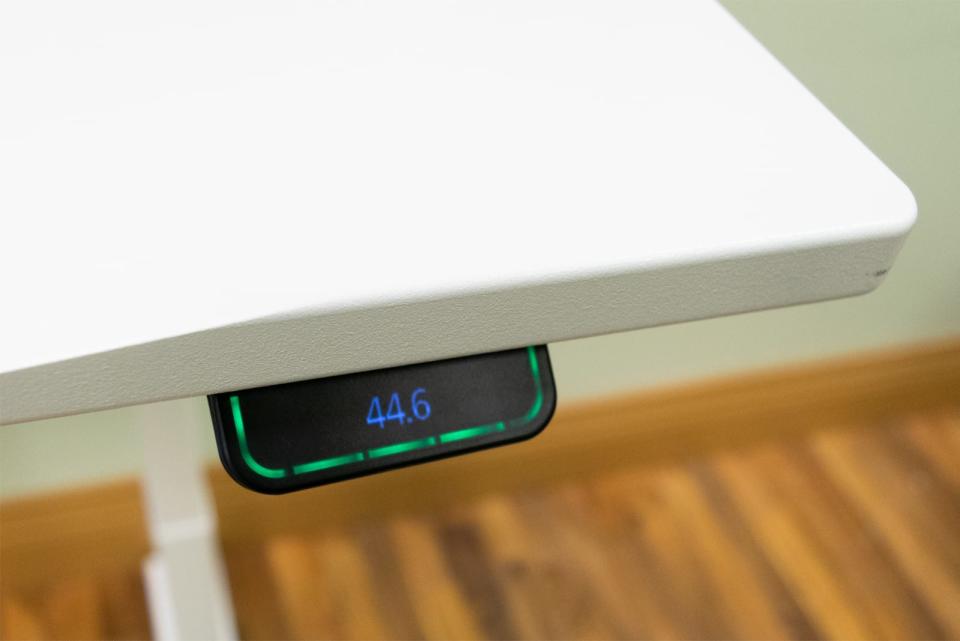
Kamron Kunce, vice president of sales and marketing at Updesk, wrote in an email reply to our findings (with video of the desk during testing) that, while all standing desks experience some sort of wobble, he was "shocked" at what we experienced, and unable to duplicate it on any desks in Updesk's Nashville showroom. Kunce suggested tightening the screws on each footer; I tightened those (and every other bolt and screw), and the stability was the same. Regarding assembly, Kunce wrote that rough handling during shipping could have bent one of the mounting brackets, or that I used a power drill to screw into the brackets (I did not).
Uplift V2 Commercial
Uplift sells a commercial version of its newest frame. It's slightly more stable than the regular version we recommend, because it comes with a crossbar. But the biggest reason for the commercial label (and $200 price difference) is to help companies meet an ergonomic standard that accommodates a wider range of working heights. The commercial Uplift moves between 22.6 and 48.7 inches, roughly covering people from 5 feet to 6 feet 3 inches tall, which is a lower minimum height, but also a lower maximum height than the regular version. The Commercial version also adds thicker legs and a crossbar, to counteract the inherent instability of longer lifting legs. Most people don't need to pay extra for it.
Full-size standing desks we previously tested
The Xdesk Terra (originally sold under the NextDesk brand) is beautiful, and was the first standing desk we recommended. Since then, the Uplift and its near competitors have gotten better-looking and sturdier, and the average price of a nice standing desk is now about half that of the Terra.
Xdesk's parent company offers a more competitively priced brand, Evodesk. The predrilled holes on a 63-inch dark bamboo model we purchased in 2016 were alternately narrow or loose, making assembly a pain, and the desk didn't feel seated on the frame. We saw more front-to-back wobble and typing wobble than with the Jarvis or Uplift. Given that it costs more than our picks when similarly configured, we recommend passing.
Autonomous sells adjustable standing desks starting at roughly $500 less than the Jarvis. We tested a dual-motor version, in a smaller configuration no longer sold. The predrilled holes were rough, or not where they were supposed to be. The instructions were the most confusing of any desk we assembled. The desk itself, a T-shaped desk with Jiecang lifts, is okay, mechanically, for its $300 cost, if you don't need a good-looking desk, and don't load much weight on it.
The Autonomous ordering experience, however, was painful for another Wirecutter writer. In summary: a two-month shipping delay, a series of emails to pitch a "new frame design," receiving a one-motor desk after ordering a two-motor model, missing protective feet, and a flaw with the lifting mechanism that the company saw often enough that they created a YouTube video for it. We emailed Justin Lucas, a director at Autonomous, about these matters. Lucas told us in mid-August 2016 that Autonomous would shift to another motor and control-box maker in early September of that year, and that the shipping delays were "good symptoms of startup scaling and fast growth." These were not reassuring answers.
The NewHeights Elegante comes from one of the first standing desk companies we discovered. The Elegante is a huge step in the right direction, but you're paying a lot ($1,200 to $1,800) for a desk that isn't as sturdy as it could be, with a cluttered wire-management system and an inspired but imperfect control panel.
The GeekDesk v3 is a basic desk—no frills, no accessories, just a tabletop and a frame. It has a simple design, it works well, and it looks fine. The Jarvis has a superior height range and lifting capacity, as well as a much longer warranty. But unless you go with a laminate or veneer desktop, the GeekDesk v3 ends up costing more than our picks (though shipping is now free, compared with when we first tested it in 2013).
Other full-size standing desks we have not tested:
Herman Miller's Renew, sold primarily in bulk through office-outfitting retailers.
Varidesk's full-size Pro Desk 60, which is mechanical rather than electric, and holds only 50 pounds.
The IKEA Bekant, which two Wirecutter commenters returned for stability problems, and about which we have read more problems and negative reviews in review sites and forums than any other standing desk.
This guide may have been updated by Wirecutter. To see the current recommendation, please go here.
When readers choose to buy Wirecutter's independently chosen editorial picks, Wirecutter and Engadget may earn affiliate commissions.
